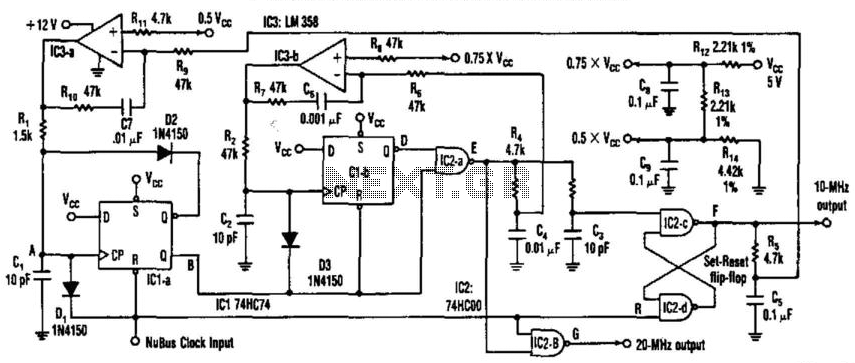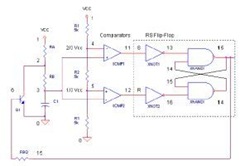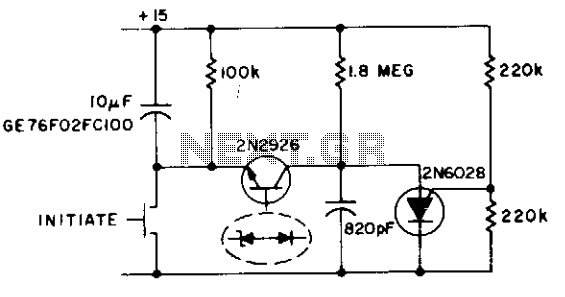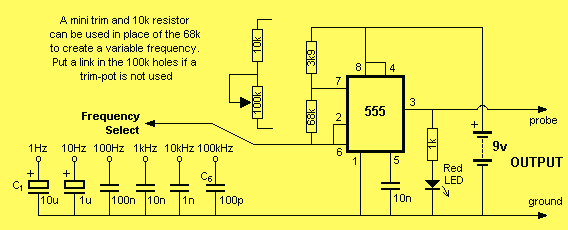
Switchable Output Crystal Oscillator
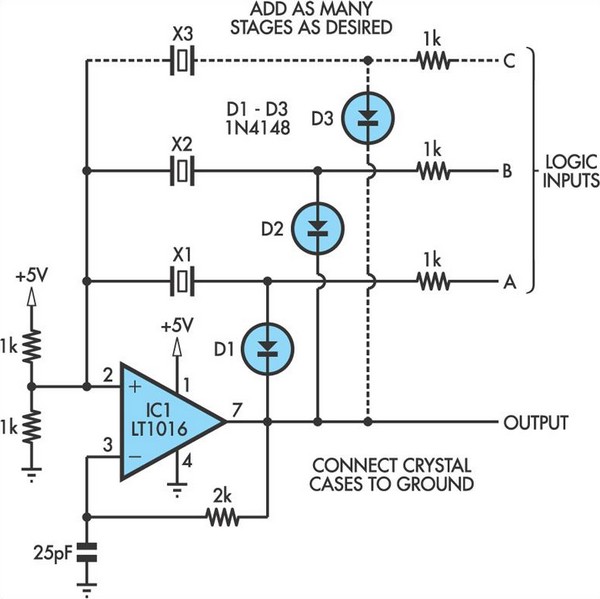
This oscillator circuit allows crystals to be electronically switched by logic commands. To understand the circuit, it is helpful to initially disregard all crystals and consider all diodes as shorts while their associated 1kΩ resistors are treated as open. The two 1kΩ resistors at the non-inverting input of IC1 (LT1016) establish the output at half the supply voltage, which is +2.5V. The RC network connecting the output to pin 3 creates phase-shifted feedback, making the circuit appear as a wide-band unity gain follower at DC. When crystal X1 is inserted (with D1 temporarily shorted), positive feedback is activated, and oscillation begins at the crystal's resonant frequency. If D1 and its 1kΩ resistor are included in the circuit, oscillation will only persist if logic input A is biased high. Likewise, the circuit will only function at crystal X2's frequency if logic input B is high. Additional branches with crystals, diodes, and 1kΩ resistors allow for the logic selection of the crystal frequency. For AT cut crystals, approximately one millisecond is needed for the circuit output to stabilize due to the high Q factors involved. Crystal frequencies can reach up to 16MHz before propagation delays in the comparator hinder reliable operation.
The oscillator circuit operates by utilizing a combination of logic control and feedback mechanisms to switch between different crystal frequencies. The core component, the LT1016 operational amplifier, is configured in a way that it maintains a stable output at half the supply voltage, which is critical for ensuring that the circuit can respond effectively to input changes. The resistors and the RC network play a pivotal role in establishing the gain and phase characteristics necessary for oscillation.
Upon the insertion of a crystal, the circuit enters a feedback loop that reinforces oscillation at the specific frequency of that crystal. This is facilitated by the removal of the short across D1, which allows the circuit to enter a state where positive feedback is sustained. The logic inputs A and B serve as control signals that selectively enable oscillation based on the desired frequency, providing flexibility in the oscillator's operation.
The design incorporates additional branches for multiple crystals, which can be selected through their corresponding diodes and resistors. This allows for rapid switching between frequencies, which is advantageous in applications requiring dynamic frequency adjustments. The stabilization time of approximately one millisecond for AT cut crystals is a consideration in timing applications, as it impacts the responsiveness of the circuit. The ability to operate at frequencies up to 16MHz demonstrates the circuit's capability for high-speed applications, although care must be taken to account for propagation delays that may occur in the comparator at these higher frequencies. Overall, this oscillator circuit exemplifies a sophisticated integration of analog and digital control elements to achieve versatile frequency generation.This oscillator circuit permits crystals to be electronically switched by logic commands. The circuit is best understood by initially ignoring all crystals. Furthermore, assume that all diodes are shorts and their associated 1kO resistors open. The two 1kO resistors at the non-inverting input of IC1 (LT1016) set the output to half the supply, ie, +2. 5V. The RC network from the output to pin 3 sets up phase-shifted feedback and the circuit looks like a wide-band unity gain follower at DC. When crystal X1 is inserted (remember, D1 is temporarily shorted) positive feedback occurs and oscillation commences at the crystal`s resonant frequency.
If D1 and its 1kO resistor are then considered to be part of the circuit, oscillation can only continue if logic input A is biased high. Similarly, the circuit can only operate at crystal X2`s frequency if logic input B is high. Additional crystal/diode/1kO resistor branches permit logic selection of the crystal frequency. For AT cut crystals about a millisecond is required for the circuit output to stabilise due to the high Q factors involved.
Crystal frequencies can be as high as 16MHz before propagation delays in the comparator prevent reliable operation. 🔗 External reference
The oscillator circuit operates by utilizing a combination of logic control and feedback mechanisms to switch between different crystal frequencies. The core component, the LT1016 operational amplifier, is configured in a way that it maintains a stable output at half the supply voltage, which is critical for ensuring that the circuit can respond effectively to input changes. The resistors and the RC network play a pivotal role in establishing the gain and phase characteristics necessary for oscillation.
Upon the insertion of a crystal, the circuit enters a feedback loop that reinforces oscillation at the specific frequency of that crystal. This is facilitated by the removal of the short across D1, which allows the circuit to enter a state where positive feedback is sustained. The logic inputs A and B serve as control signals that selectively enable oscillation based on the desired frequency, providing flexibility in the oscillator's operation.
The design incorporates additional branches for multiple crystals, which can be selected through their corresponding diodes and resistors. This allows for rapid switching between frequencies, which is advantageous in applications requiring dynamic frequency adjustments. The stabilization time of approximately one millisecond for AT cut crystals is a consideration in timing applications, as it impacts the responsiveness of the circuit. The ability to operate at frequencies up to 16MHz demonstrates the circuit's capability for high-speed applications, although care must be taken to account for propagation delays that may occur in the comparator at these higher frequencies. Overall, this oscillator circuit exemplifies a sophisticated integration of analog and digital control elements to achieve versatile frequency generation.This oscillator circuit permits crystals to be electronically switched by logic commands. The circuit is best understood by initially ignoring all crystals. Furthermore, assume that all diodes are shorts and their associated 1kO resistors open. The two 1kO resistors at the non-inverting input of IC1 (LT1016) set the output to half the supply, ie, +2. 5V. The RC network from the output to pin 3 sets up phase-shifted feedback and the circuit looks like a wide-band unity gain follower at DC. When crystal X1 is inserted (remember, D1 is temporarily shorted) positive feedback occurs and oscillation commences at the crystal`s resonant frequency.
If D1 and its 1kO resistor are then considered to be part of the circuit, oscillation can only continue if logic input A is biased high. Similarly, the circuit can only operate at crystal X2`s frequency if logic input B is high. Additional crystal/diode/1kO resistor branches permit logic selection of the crystal frequency. For AT cut crystals about a millisecond is required for the circuit output to stabilise due to the high Q factors involved.
Crystal frequencies can be as high as 16MHz before propagation delays in the comparator prevent reliable operation. 🔗 External reference
